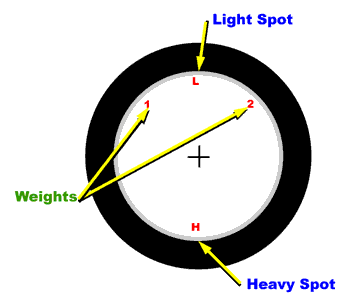
You are all aware of the importance of properly balanced tires. I like to perform all the maintenance work on my bike, and balancing the tires is one of the items I can do.
It's elementary that the heaviest part of the tire/wheel assembly will rotate to the bottom, barring friction. But there is a bit of friction caused by the wheel bearing seals. The first few times I balanced my own tires I had no special equipment for the job. I devised a way to minimize the bearing friction effects using what I had available. I slipped the front axle through the bearings, then put a Phillips screwdriver through the hole in the end of the axle. I lifted this alongside my workbench, and supported the threaded end of the horizontal axle shaft on the bench. Holding the other end of the shaft, I quickly twisted the shaft back and forth a few degrees using the screwdriver as a lever. This allowed the wheel to rotate until the heavy spot was at the bottom. I marked the light spot with a bit of chalk.
Now this procedure was pretty cumbersome, though it was repeatable, thus effective. Then I read a post by Whit Brown about supporting the axle shaft on another set of wheel bearings propped up by jack stands. That's all I needed to graduate to my present set-up.

I purchased a pair of front wheel bearings to fit my bike. I carefully removed the seals and washed out all the grease. I put some light oil on them so they wouldn't rust in my garage. (I later replaced the bearings in my bike as preventive maintenance. Now I use the old bearings for my balancing.)
This set-up works very well, and is much easier and more sensitive than my first procedure. I use the Honda clip-on wheel weights. One weight almost never is the exact amount needed for perfect balance. My procedure is to use two equal weights, positioned equidistant from the light spot on the wheel as shown in the drawing below. I adjust the spacing between the two weights, closer together when the imbalance is more, and farther apart when the wheel imbalance is less. Using this method, it is possible to get the balance close enough that the wheel will stop rotation in random positions, meaning there is no heavy spot anymore. The wheel spokes sometime make this impossible, but the resulting imbalance is not perceptible when riding.
I've since started using the stick-on lead weights, using pairs of weights on either side of the wheel, four weights in total.

[ Top of Page ]
Last updated on January 27, 2014 © 2004-2014 M. E. Martin, all rights reserved.